Finding Japanese Optimists in the Demographics of Doom
Economics / Japan Economy Jun 09, 2013 - 03:31 PM GMTBy: John_Mauldin
 As kids, not knowing that we were being politically incorrect on so many levels, we would shout “Geronimo!” when we were playing war or getting ready to do something reckless. (For those not familiar, Geronimo was a rather fearsome Apache chief who plagued Mexico and the American cavalry.) Sam Houston and his fellows cried, “Remember the Alamo!” as they rode down upon Santa Ana at San Jacinto. The British went to battle with “God Save the Queen [or King]!” Confederate soldiers took up the rebel yell as they charged live bullets and fixed bayonets. Every good war movie has its own memorable moment of the battle charge.
As kids, not knowing that we were being politically incorrect on so many levels, we would shout “Geronimo!” when we were playing war or getting ready to do something reckless. (For those not familiar, Geronimo was a rather fearsome Apache chief who plagued Mexico and the American cavalry.) Sam Houston and his fellows cried, “Remember the Alamo!” as they rode down upon Santa Ana at San Jacinto. The British went to battle with “God Save the Queen [or King]!” Confederate soldiers took up the rebel yell as they charged live bullets and fixed bayonets. Every good war movie has its own memorable moment of the battle charge.
In Japan, the term Banzai! literally means “ten thousand years” and can be used to wish someone long life and happiness. But during World War II, “Banzai!” was shouted in battle. It was the Japanese equivalent of "Long live the king!" – but to soldiers on the other side it came to mean a suicidal, hell-for-leather attack.
If the central bankers of the world think they're hearing a battle cry of “Banzai!” from the lips of their Japanese brethren, they may not be far from wrong, because the Japanese are indeed on a mad charge to fight deflation at all costs. As with all good suicidal charges, at least in legend and lore, once the cry has gone up and the thundering charge has begun, there can be no turning back.
For the last three weeks, I have been making what I personally think is a rather strong case that the Japanese have embarked on what may be simultaneously the most outrageous, intriguing, and desperate monetary policy experiment by a major economic power in history. (Those letters are here, here, and here). The Japanese are rapidly coming to their own Endgame, the end of their ability to borrow money at interest rates that are economically rational. If interest rates on Japanese bonds rise to a mere 2.2%, 80% of tax revenues will go just to pay the interest on their debt. At a 245% debt-to-GDP ratio, they are in desperate straits, and they know it. And desperate times call for desp erate measures.
To get to where they want to go, to grow their way out of their deflationary problem, the Japanese need both inflation and real growth. Real growth can come from massively increased exports, and inflation can even come from an increase in export prices. Both results can be obtained by weakening the yen. As I have shown, they need to devalue the yen by 15-20% a year for many years in order to break through to the other side.
That should be easy, at least in theory. Inflation, Milton Friedman famously said, is “always and everywhere a monetary phenomenon.” If you want to create inflation and devalue your currency, just print more money. A second shift in the print shop is in order, and if that doesn’t produce the desired results a third shift can be arranged, and then you can run full tilt on weekends. And soon maybe it will be time to build another print shop.
But that is the theory. In practice it may be harder for Japan to grow and generate inflation than it might be for other major nations. Today we'll focus on Japanese demographics. While the letter is full of graphs and charts, it does not paint a pretty picture. The forces of deflation will not go gently into that good night.
But first, a couple of quick notes. At the end of the letter, there is a link for Mauldin Circle members to the first crop of videos from my recent Strategic Investment Conference (co-hosted with Altegris Investments). These videos highlight some of our most popular speakers, including Kyle Bass, Niall Ferguson, Mohamed El-Erian, Lacy Hunt, and David Rosenberg. The final batch of videos will be ready in a few weeks. (If you are already a member of the Mauldin Circle in the US, you should have been sent that link.)
Second, yesterday in New York we taped our video webinar in which I was joined by John Hussman, Barry Ritholtz, Mohamed El-Erian, Kyle Bass, and David Rosenberg. It was quite a day, and you can join us (for free) when the event goes live on Tuesday at 2 PM EDT. Click right here to register.
And now, let’s shout “Banzai!” together as we dive right into Japanese demographics.
Creating inflation is the goal, but Prime Minister Abe and Bank of Japan Governor Kuroda face a very difficult task. Unlike in Zimbabwe, Argentina, and a host of other countries with defunct fiat currencies, in Japan it is not simply a matter of racking up untenable amounts of debt and then printing tons of money. If it were that simple, inflation would be rampant in Japan, for the Japanese have borrowed more than any country in modern history (relative to their size). And while their efforts to create inflation have been futile, it is not for lack of trying: the Japanese have been actively pursuing quantitative easing for many years. Carl Weinberg of High Frequency Economics, writing in the Globe and Mail, gives us a very succinct summary of the Japanese dilemma:
The National Institute of Population and Social Security Research projects that Japan’s working-age population will decline over the next 17 years, to 67.7 million people by 2030 from 81.7 million in 2010. We select 2030 as the endpoint of today’s discussion because almost all the people who will be in the working-age population by 2030, 17 years from now, have been born already. Immigration and emigration are trivial. The 17-per-cent decline in the working-age population is a certainty, not a forecast. It averages out to a decline of 0.9 per cent a year. In addition, these official projections show a rise in the population aged over 64 to 36.9 million in 2030 from 29.5 million in 2010. If the labour-force participation rate stays constant, we estimate the number of people seeking work in the economy will fall to 56.5 million by 2030 from 65.5 million today and 66 million in 2010.
What happens when a nation’s population declines and the proportion of working-age people decreases? In the first, simplest, level of analysis, the production potential of the economy declines: Fewer workers can produce fewer goods. This does not mean GDP must decline; productivity gains could offset a decline in the labour force. Also, an increase in the labour-force participation rate could mute the effect of a declining working-age population. However, even if the labour force participation rate were to rise to 100 per cent by 2030 from 81 per cent today (which it cannot, because some people have to care for the old and the young, and some are disabled or lack adequate skills or education), there would be fewer workers available in 2030 than there are today.
With fewer people working, the burden of servicing the public-sector debt will be higher for each individual worker. We project that the debt-to-GDP ratio and the debt-per-worker ratio will grow unabated over the next 17 years and beyond. Also, the rise of the ratio of retired workers to 32 per cent of the population from 23 per cent means that people who are still working in 2030 will have to give up a rising share of their income to support retirees. The disposable income of the declining number of workers will fall faster than the decline of production and employment. Overall demand of workers will decrease – with their disposable income – faster than output for the next 17 years at least. Demand will also fall as new retirees spend less than in their earning years.
Based on demographic factors alone, the decline of aggregate demand between now and 2030 will exceed the decline of output, creating persistent and widening excess capacity in the economy. Prices must fall in an economy where slack is steadily increasing. In addition, advancing technology will likely increase output per worker in the future. With overall demand and output falling, productivity gains will lower labour costs and add to downward pressure on prices. Disinflation and deflation are the companions of demographic decline.
Andrew Cates, an economist for UBS, based in Singapore, published a penetrating study on the relationship between inflation and demographics this week. He notes that countries with older populations tend to have lower inflation. That is not what the textbooks suggest, but it's what the data reveals:
Since ageing demographics will now start to feature more prominently in the outlook for many major developed and developing countries this is clearly of some significance for how inflation might evolve from here. By extension it could be of greater significance for monetary policy settings and the broader outlook for global growth and financial markets as well.
Let’s first look at the evidence. In the chart below we show average inflation levels over the last 5 years plotted against the 5-year change in the dependency ratio. The latter is the ratio of the very old and the very young to the population of working age. A shift down in that ratio implies that the population in a given country is getting younger (and vice versa). The chart therefore shows that those countries that have been getting older in recent years have typically faced very low inflation rates and, in the case of Japan, deflation. In the meantime those countries that have been getting younger in recent years, such as India, Turkey, Indonesia and Brazil, have faced relatively high inflation rates.
Cates looks not just at Japan but takes a more global view. However, Japan does stand out in this chart. (I do not have a link, as this work is just available from UBS for now.) I added the red box to highlight Japan:
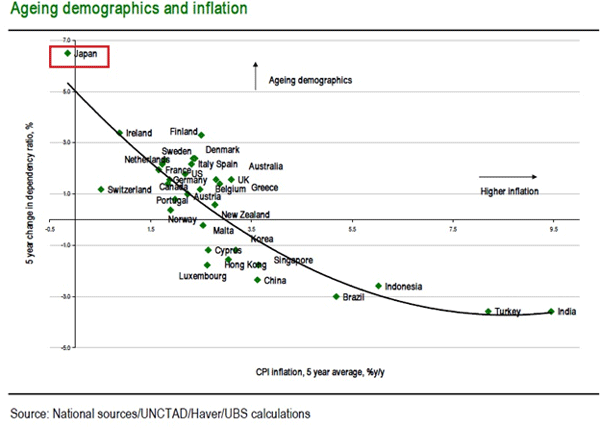
And while correlation is not causation, the following graph of inflation vs. population growth in Japan does make you think.
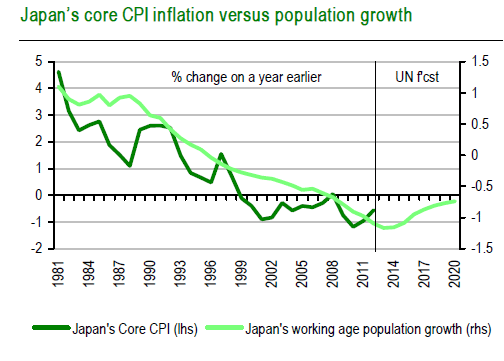
And let's throw in one more chart from Mr. Cates. He notes that textbook economics suggests that a falling workforce tends to put upward pressure on wages (labor is just an input resource on the supply side), and thus one ends up with cost-push inflation:
This, though, ignores other factors that are arguably of some relevance in the domestic inflation-generating process. Demographic influences for example will influence an economy’s natural demand for consumer durables, its housing stock and broader credit aggregates. The latter is certainly borne out by the reasonably close correlation that exists between credit and ageing in the chart below.
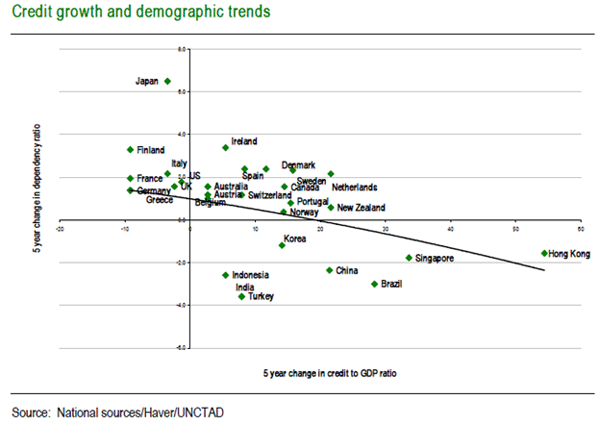
As negative as all of the above sounds, you can find those who think the Japanese economy can turn itself around, that inflation can be drummed up, and that Japanese interest rates – even given the amount of monetization they are contemplating – will not rise. Seriously.
Bloomberg News did a survey of five former Bank of Japan officials, all of whom believe that “any gains in government bond yields will be contained over the next two years.” Four of the five also don’t think 2% inflation is possible. Even with a wide-open printing press.
You can decide for yourself whether Abenomics can accomplish 3 or 4% nominal growth. Just go to this story with an interactive graph from Reuters Breakingviews). (The screen shot included below is just intended to tantalize you to head over there.) Play with variables in the graph and decide what you think is possible. If you start with today’s trends, potential GDP growth is much less than 1%.
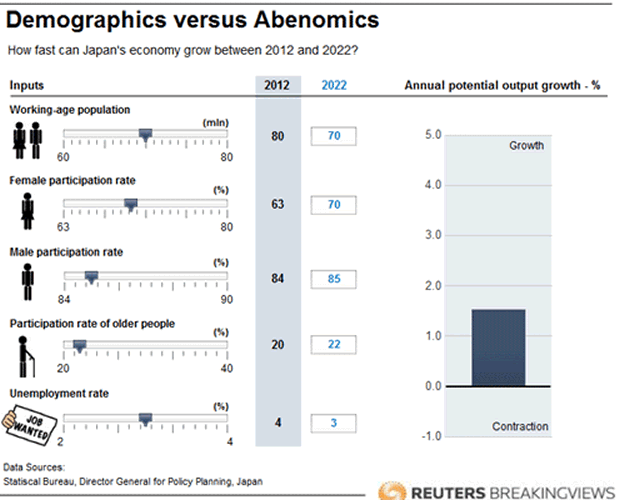
But what if, like Andy Mukherjee at Breakingviews, you get more optimistic? Japanese women participate in the labor force at just 63%, about the lowest female participation rate among developed nations. What if the participation rate of women rises dramatically because of the 250,000 new daycare jobs Abe has promised? And what if older people decide to work longer? And maybe men will do more (even though they have one of the highest participation rates now). And the unemployment rate could drop by, say, 40%.
If you make such assumptions then you can get to a 1.5% growth rate (which, as I showed last week, is not anywhere near enough!). Abe has bet big that creating inflation will encourage people to no longer postpone spending in hopes that things will get even cheaper. Never mind that that is not how older people think. And those are the people in Japan with money to spend. Abe's program is yet another case of operating on the basis of textbook economic theory rather than the reality that is staring you in the face.
An aging population means that someone has to take care of parents as they get older. And in Japan (as in many other places) that responsibility usually falls to the women, which lowers the female participation rate. And where will they get those 250,000 daycare workers? And who is going to pay for them? Abe also promises that by 2020 the Japanese government will be running a surplus and that deficits will be down to the rate of nominal GDP growth within a few years. Which programs will get cut to pay for those daycare workers? And what about the serious need for nursing-home workers? There are far more old people in Japan than there are toddlers.
While we are on the matter of promises, Abe also says he will enter into free-trade agreement talks with the rest of Asia and the US and open up the Japanese economy. All this while his currency is plummeting 15% a year, upsetting his neighbors and drastically changing the terms of trade? Now he wants to play nice in the global-trade sandbox? I was on Bloomberg with Tom Keene this morning. One of the other guests, talking about Japan’s opening up free-trade talks with the US, mentioned rice, which Japan famously protects, as a potential bargaining chip. “So,” I responded, “Japan decides it wants to drop the value of the yen by 50% and then open up its rice trade?” I was not impressed. I am a fairly big proponent of free trade, but Japan’s getting religion on free trade now, when they are on the brink of crisis, seems a tad disingenuous.
Abe has proposed an economic reform package comprising “three arrows”: aggressive monetary easing, labor and other structural reforms (which will be politically very difficult to achieve) intended to induce private-sector growth-promoting investment, and a flexible fiscal policy (whatever that means – I guess, since it's "flexible," it means whatever he decides it means). He gave a speech this week on those reforms, and the market promptly threw up. The “reforms” he touted were more of the same old same old. At dinner on Wednesday night, Art Cashin modified the opening line from the old Longfellow poem: “I shot an arrow into the air… and it landed in my foot.”
Not that I think Abe had much choice. He has a critical election next month. Touting a policy that allows employers a freer hand in firing workers is not likely to win over many voters, but he must get serious about reform if he is to have any hope of limiting the disaster he faces.
 I truly do feel sorry for retirees in Japan. I am reminded of that wonderful Japanese movie from the '50s, The Ballad of Narayama. It depicted ubasute (å§¥æ ¨, "abandoning an old woman"), a custom allegedly practiced in Japan in the distant past, whereby an infirm or elderly relative was carried up a mountain or to some other remote, desolate place and left there to die.
I truly do feel sorry for retirees in Japan. I am reminded of that wonderful Japanese movie from the '50s, The Ballad of Narayama. It depicted ubasute (å§¥æ ¨, "abandoning an old woman"), a custom allegedly practiced in Japan in the distant past, whereby an infirm or elderly relative was carried up a mountain or to some other remote, desolate place and left there to die.
While not as straightforward, the last 20 years of policy choices are producing results that are going to feel to the elderly as if they have been abandoned. It's just a much more protracted approach and one that is not so personally intimate as that depicted in the movie.
Gentlemen, They Offer Us Their Flank
My friend the serious raconteur Bill Bonner tells the story of the Battle of the Marne in WWI, relating it to inflation. Quoting (with a few edits):
What's remarkable about inflation is that there is so little of it. It makes us think this [inflation/deflation] story may have a twist. You remember the famous German general von Kluck, from whom we get the expression, "You dumb kluck"?
Von Kluck was chasing the French down the Marne in 1914. Victory appeared close at hand; the French were pulling back. Von Kluck, who had orders to attack Paris, decided instead to pursue the French army. He was convinced they were beaten.
All he had to do was keep the pressure on ... and they would surrender.
Some of his field commanders, however, noted that they were picking up very few prisoners. Normally, an army that is beaten throws off many discouraged and confused soldiers. Since there were so few, the commanders reasoned that the French army was still intact; it was merely retreating in good order and could turn and surprise the Germans at any time.
The commanders were right. France's aging general, Gallieni, who was in charge of the Paris garrison, realized that the Germans were making a fatal mistake. By pursuing the troops down the Marne, rather than attacking Paris, they exposed themselves to a counterattack from the city itself.
"Gentlemen," he is said to have remarked to his staff, "They offer us their flank."
The French accepted the offer: they attacked. Using thousands of taxicabs, they quickly moved troops to the Marne Valley and caught the Germans unprepared. The Battle of the Marne turned the German army around and ultimately cost them the war.
The Japanese are charging the deflationary battle lines, crying "Banzai!" This attack is all or nothing. I think the Japanese are offering us investors their flank. This week’s action in the markets showed us that this battle will not be one-sided. It will often get ugly. But I want to keep reiterating what I have been saying for a long time: shorting the Japanese government is the trade of the decade. That is the largest position in my personal portfolio, and it is going to get larger, as I intend to fully swap the mortgage I just took out this week into yen. As I said to Tom Keene this morning, it is my intention (more accurately styled as hope) to let Abe-san and Kuroda-san pay for a large chunk of my new apartment through their policy of destroying the yen. I have to admit to feeling good when the yen backs up like it has this week, since that gives me a chance to get my trade on at a better entry.
Will I succeed? Time will tell, but I am joined by Japanese public pension funds that have announced they will reduce their holdings of local bonds while increasing their share of both domestic and, in particular, foreign equities. No time frame was provided in the data I saw, although indications are that they have already started. (Hat tip Kiron Sarkar.)
It is time to close this week’s letter, but these are topics we'll need to return to. But before we go, I want to include one more table I came across while researching this topic. It is a comparison of the dependency ratio among developed countries. This is the ratio of retired and people under 16 compared to the work force. As it turns out, Japan is not in last place. France, Italy, and Hungary have worse demographics. This chart fairly screams for an entire future letter.
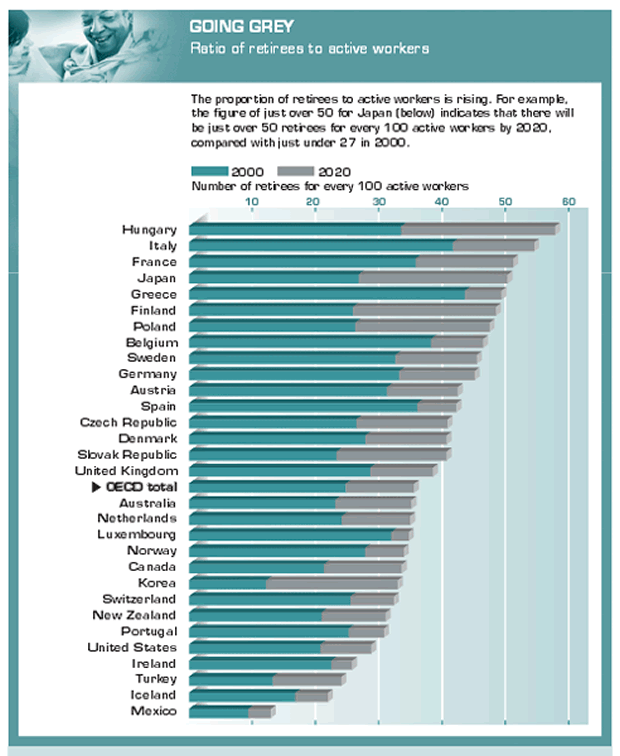
The Strategic Investment Conference Videos
The first group of videos from the 2013 Strategic Investment Conference is now available! These videos feature some of our most popular speakers, including Kyle Bass, Mohamed El-Erian, Lacy Hunt, and more. If you a Mauldin Circle member, you can access the videos by going to www.altegris.com to log in to your “members only” area of the Altegris website. Upon login, click on the “SIC 2013” link in the upper left corner to view the videos and more. If you have forgotten your login information, simply click “Forgot Login?” and your information will be sent to you.
If you are not already a Mauldin Circle member, the good news is that this program is completely free. In order to join, you must, however, be an accredited investor. Please register here to be qualified by my partners at Altegris and added to the subscriber roster. Once you register, an Altegris representative will call you to provide access to the videos, transcripts, and summaries from selected speakers at our 2013 conference. (Note: for those members outside of the US, I will work on getting the videos up for you within a few weeks.)
Monaco, Cyprus, Belgrade(?), Croatia, and Switzerland
I am home for a week. I finally closed on my mortgage on the new apartments, and construction to turn them into one apartment begins Monday. I will at last move out of the hotel and into a temporary place next week, although given my schedule for the next few weeks, I will not be home until July to enjoy it.
I go to Monaco in about ten days for a speech at GAIM, then I have a few days off before I go to Nicosia, Cyprus, where I am beginning to schedule meetings and may deliver a public speech at the university there. Then I will overnight in some spot on my way to the coast of Croatia, where I will spend the weekend with that brilliant and wicked-funny Irish economist David McWilliams and his family before dashing off to Geneva and then returning home.
It is time to hit the send button. I had to get up at 3:30 AM Texas time to be with Tom Keene (I am not sure there is another man I would do that for), and it is now officially a very, very, very long day. It has been a good week, although having to have make-up applied every morning for four straight days has given me additional sympathy for the distaff side of the human race. When was the last time you talked to strangers (or your daughters) about toner color and blending a base foundation? The world has taken me through far different turns than I once imagined it ever would. But it is all fun.
Your proud new father of a bouncing baby (yen?) mortgage analyst,
John Mauldin
subscribers@MauldinEconomics.com
Outside the Box is a free weekly economic e-letter by best-selling author and renowned financial expert, John Mauldin. You can learn more and get your free subscription by visiting www.JohnMauldin.com.
Please write to johnmauldin@2000wave.com to inform us of any reproductions, including when and where copy will be reproduced. You must keep the letter intact, from introduction to disclaimers. If you would like to quote brief portions only, please reference www.JohnMauldin.com.
John Mauldin, Best-Selling author and recognized financial expert, is also editor of the free Thoughts From the Frontline that goes to over 1 million readers each week. For more information on John or his FREE weekly economic letter go to: http://www.frontlinethoughts.com/
To subscribe to John Mauldin's E-Letter please click here:http://www.frontlinethoughts.com/subscribe.asp
Copyright 2013 John Mauldin. All Rights Reserved
Note: John Mauldin is the President of Millennium Wave Advisors, LLC (MWA), which is an investment advisory firm registered with multiple states. John Mauldin is a registered representative of Millennium Wave Securities, LLC, (MWS), an FINRA registered broker-dealer. MWS is also a Commodity Pool Operator (CPO) and a Commodity Trading Advisor (CTA) registered with the CFTC, as well as an Introducing Broker (IB). Millennium Wave Investments is a dba of MWA LLC and MWS LLC. Millennium Wave Investments cooperates in the consulting on and marketing of private investment offerings with other independent firms such as Altegris Investments; Absolute Return Partners, LLP; Plexus Asset Management; Fynn Capital; and Nicola Wealth Management. Funds recommended by Mauldin may pay a portion of their fees to these independent firms, who will share 1/3 of those fees with MWS and thus with Mauldin. Any views expressed herein are provided for information purposes only and should not be construed in any way as an offer, an endorsement, or inducement to invest with any CTA, fund, or program mentioned here or elsewhere. Before seeking any advisor's services or making an investment in a fund, investors must read and examine thoroughly the respective disclosure document or offering memorandum. Since these firms and Mauldin receive fees from the funds they recommend/market, they only recommend/market products with which they have been able to negotiate fee arrangements.
Opinions expressed in these reports may change without prior notice. John Mauldin and/or the staffs at Millennium Wave Advisors, LLC and InvestorsInsight Publishing, Inc. ("InvestorsInsight") may or may not have investments in any funds cited above.
Disclaimer PAST RESULTS ARE NOT INDICATIVE OF FUTURE RESULTS. THERE IS RISK OF LOSS AS WELL AS THE OPPORTUNITY FOR GAIN WHEN INVESTING IN MANAGED FUNDS. WHEN CONSIDERING ALTERNATIVE INVESTMENTS, INCLUDING HEDGE FUNDS, YOU SHOULD CONSIDER VARIOUS RISKS INCLUDING THE FACT THAT SOME PRODUCTS: OFTEN ENGAGE IN LEVERAGING AND OTHER SPECULATIVE INVESTMENT PRACTICES THAT MAY INCREASE THE RISK OF INVESTMENT LOSS, CAN BE ILLIQUID, ARE NOT REQUIRED TO PROVIDE PERIODIC PRICING OR VALUATION INFORMATION TO INVESTORS, MAY INVOLVE COMPLEX TAX STRUCTURES AND DELAYS IN DISTRIBUTING IMPORTANT TAX INFORMATION, ARE NOT SUBJECT TO THE SAME REGULATORY REQUIREMENTS AS MUTUAL FUNDS, OFTEN CHARGE HIGH FEES, AND IN MANY CASES THE UNDERLYING INVESTMENTS ARE NOT TRANSPARENT AND ARE KNOWN ONLY TO THE INVESTMENT MANAGER.
John Mauldin Archive |
© 2005-2022 http://www.MarketOracle.co.uk - The Market Oracle is a FREE Daily Financial Markets Analysis & Forecasting online publication.




